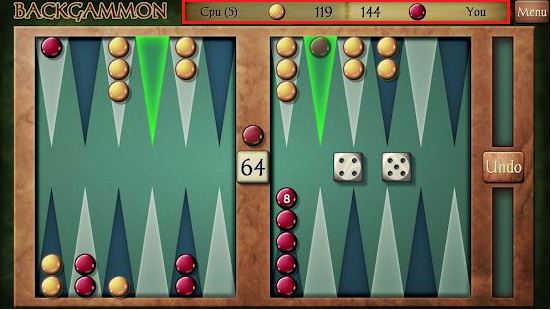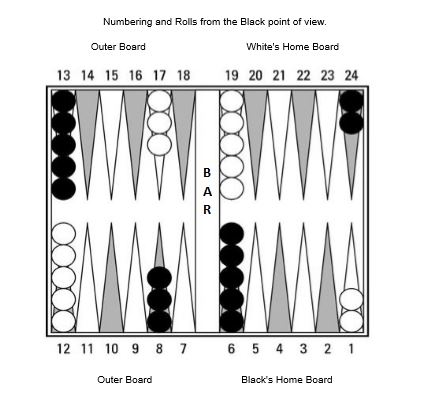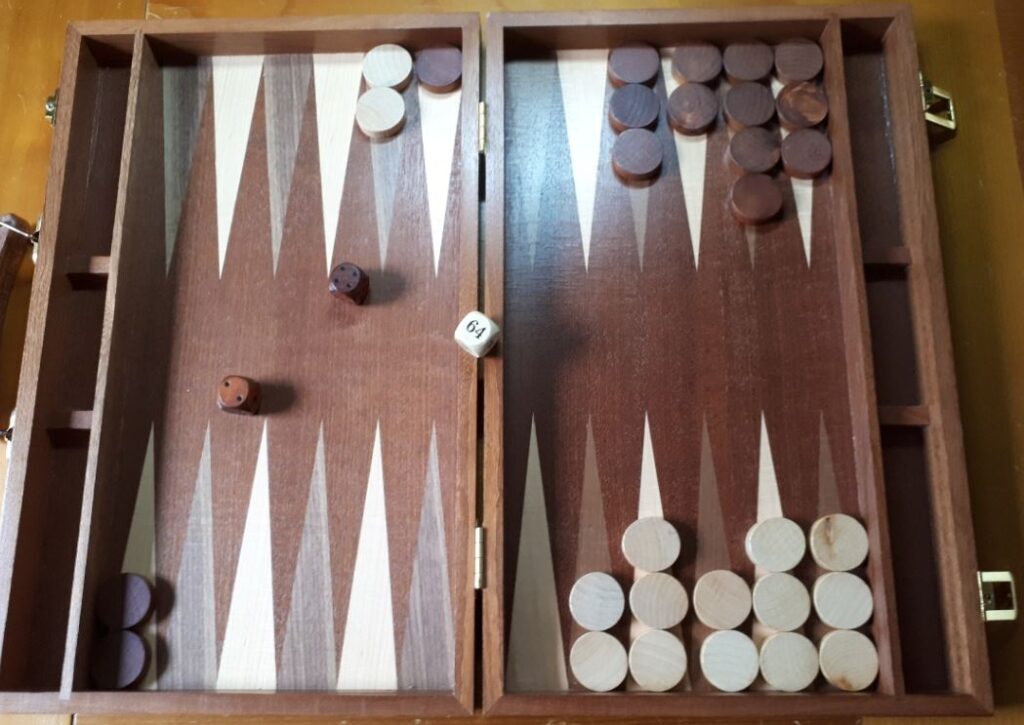Last updated on October 29, 2022
This is another post in our Deluxe Backgammon series for beginners. In our last article, we looked at bearing off the last two checkers. In this post, we are going to take a look at counting pips. Backgammon is essentially a racing game and most of the time the player who is ahead in the race is winning the game. The leader of the race can be determined by comparing the relative pip counts, which is simply a tally of the number of dice pips each player needs to roll in order to bear off all of their checkers.
If you have played backgammon electronically, either online or on a tablet or PC, you will have undoubtedly seen the pip count displayed on the screen. This is calculated for you automatically after each move. If you haven’t seen the pip count displayed, there may be a setting that is switched off. This is convenient for both players and they can make doubling decisions based on the displayed pip count. However, if you are sitting across the board from a real-life human opponent, there is no such luxury. In this instance, pip counts need to be performed manually and knowing how to do so will give you an enormous advantage over an opponent who is making visual estimates.
The starting count
At the start of a game of backgammon, both players have a pip count of exactly 167. At first, we will take a look at how this starting value is calculated using the diagram below. The view is from the black checker’s perspective. Each of the points is numbered and gives the number of pips required to bear checkers off from that position. For example, the two checkers furthest from your home board are sitting on the point numbered 24. Each of these checkers needs to move 24 pips to bear off. The calculation at the start works like this:
2 x 24 = 48 for the back checkers.
5 x 13 = 65 for the checkers at black’s mid-point.
3 x 8 = 24 for the checkers on the 8-point.
5 x 6 = 30 for the checkers on black’s 6-point.
48 + 65 + 24 + 30 = 167
Obviously, at the start, the same count applies to the white checkers.
Live count
Next, let’s take a look at a pip count for a game in progress. This is a photograph taken from one of the last live Deluxe Backgammon sessions before the Covid-19 lockdown. Black has just rolled and managed to escape a checker from the 13-point to the bar point. Ideally, white wants to roll a double 6, 4 or 3 to escape their back checkers and race home. The first thing you will note here is that there are no numbers printed on the board, you will need to work that out on your own.
Looking at the white checkers:
2 x 17 = 34
2 x 5 = 10
3 x 4 = 12
2 x 3 = 6
3 x 2 = 6
3 x 1 = 3
34 + 10 + 12 + 6 + 6 + 3 = 71
Looking at the black checkers:
2 x 13 = 26
1 x 7 = 7
3 x 4 = 12
2 x 3 = 6
4 x 2 = 8
3 x 1 = 3
26 + 7 + 12 + 6 + 8 + 3 = 62
Comparison
Based on this pip count we can see that black has a lead of 9 pips in the race. The calculation, with practice, can be done within minutes for both sides. You need to do this manually and within your head, we don’t know of any players that allow this calculation to be performed on paper. In this case, black has a lead of nearly 13% and is in a strong position to offer a double, but doubling decisions is something we will discuss in a future post. The rule of 8 can also be applied to tactical decisions if you know the pip count. This is a method that considers a position based on which side is ahead on the number of ‘average rolls’.
For the record, in this game white rolled low for a couple of throws and crunched their home board. Black didn’t roll much better leaving a blot on their mid-point. White then rolled the double six and the race was on. It wasn’t much of a race in the end, as white rolled four more doubles in the next six rolls and won comfortably.
Practice
Just like any other aspect of backgammon, practice makes perfect. Pip counting is an essential skill of backgammon and it is worth taking the time out to master the art. It doesn’t take long and it is well worth the effort. You can practice on your own, rolling the dice for both sides and then manually counting. Start by focussing purely on the count rather than strategic or tactical play. It will be slow at first, but before too long it will become second nature. At first, it looks intimidating, but it becomes surprisingly simple once you get started. There are many other methods for counting pips and we will take a look at these in future Deluxe Backgammon posts.
Related content
Backgammon Galore – beginners guide to counting pips.




It takes some practice to master pip counting, but it is well worth it. Learning will lift your backgammon game to a new level. You will know when to break contact and run. Not many beginners know how to pip count in backgammon, some intermediate players have and idea, but all advanced backgammon players will know where they stand in the race. Good article, thanks.